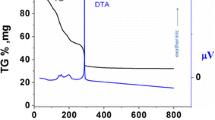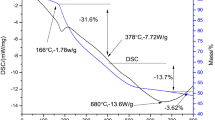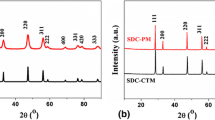Abstract
We have prepared pure electrolytes of Ce0.8Gd0.2O1.9 (CGO) and Ce0.8Sm0.2O1.9 (CSO), useful for SOFCs, by a sol–gel-related technique like the acrylamide method. This method consists of preparing a solution from the single oxides followed by gelation. Then, the combustion or decomposition of the organic molecules is initiated, producing nanometric calcined powders of the above-mentioned compounds. Thermal treatments were optimized in order to obtain good electrochemical properties of the electrolytes. We have observed that the synthesis temperature to obtain the pure phase is lower for the sol–gel samples than for the pellets prepared by solid-state reaction, and the final density is higher. The microstructure and composition of the powders were characterized by TEM, SEM, and EDX analysis. The electrical properties of the electrolytes were measured by impedance spectroscopy at different temperatures and oxygen partial pressures.








Similar content being viewed by others
References
Minh NQ, Takahashi T (1995) Science and technology of ceramic fuel cells. Elsevier, New York
Milliken C, Guruswamy S, Khandkar A (1999) J Electrochem Soc 146:872
Eguchi K, Setoguchi T, Inoue T, Aria H (1992) Solid State Ionics 52:165
Singhal SC (2000) Solid State Ionics 135:305
Hibino T, Hasimoto A, Inoue T, Tokuno J, Yoshida S, Sano M (2000) Science 288:2031
Hibino T, Wang S, Kakimoto S, Sano M (1999) Electrochem Solid-State Lett 2:317
Steele BCH (2000) Solid State Ionics 129:95
Huijsmans JPP (2001) Curr Opin Solid St Mater 5:317
Yamamoto O (2000) Electrochim Acta 5:2423
Kleinlogel C, Gauckler LJ (1999) In: Singhal SC, Dokiya M (eds) SOFC-V. Electrochemical Society, Pennington, 99–119:225
Park S, Vohs JM, Gorte RJ (2000) Nature 404:265
Park S, Vohs JM, Gorte RJ (1999) J Electrochem Soc 146:3603
Steele BCH (1999) Nature 400:620
Riley B (1990) J Power Sources 29:223
Minh NQ (1993) J Am Ceram Soc 76:563
Vlasov AN, Perfiliev MV (1987) Solid State Ionics 25:245
Steele BCH (2001) J Mater Sci 36:1053
Sin A, Odier P (2000) Adv Mater 12(9):649
Huang K, Feng M, Goodenough JB (1998) J Am Ceram Soc 81:357
Pérez-Coll D, Nuñez P, Frade JR, Abrantes JCC (2004) Electrochim Acta (in press)
Fagg DP, Abrantes JCC, Pérez-Coll D, Nuñez P, Kharton VV, Frade JR (2003) Electrochim Acta 48:1023
Navarro L, Marques F, Frade J (1997) J Electrochem Soc 144:267
Acknowledgements
The authors are grateful to the Spain–Portugal project HP01-82 and to Prof. J.R. Frade for his helpful comments.
Author information
Authors and Affiliations
Corresponding author
Additional information
Presented at the OSSEP Workshop “Ionic and Mixed Conductors: Methods and Processes”, Aveiro, Portugal, 10–12 April 2003
Rights and permissions
About this article
Cite this article
Piñol, S., Najib, M., Bastidas, D.M. et al. Microstructure–conductivity relationship in Gd- and Sm-doped ceria-based electrolytes prepared by the acrylamide sol–gel-related method. J Solid State Electrochem 8, 650–654 (2004). https://doi.org/10.1007/s10008-004-0506-0
Published:
Issue Date:
DOI: https://doi.org/10.1007/s10008-004-0506-0




